The Past is Still in the Picture
Nelly Moerman, author
Cis van Heertum, English translation
One of the comments often heard when people are looking at skating scenes in old paintings, in prints or in drawings, is: Yes, that’s how it was in the old times! It’s a common thing to say, for any of us. What exactly are those old times, though? What is meant by it? We have become used to assigning everything we regard as ‘old’ to the ‘old times’. But ‘old’ is a comprehensive idea, and when we speak of ‘the old times’, it follows there must have been even older times. It may seem confusing, but it is highly relevant for the interpretation of skating scenes.
Jawbone Sledge
An old skating scene from the 17th century, for example, may feature an element belonging to the Middle Ages, such as a bone sledge. A medieval jawbone sledge had no place in 17th-century reality. If a jawbone sledge is depicted, therefore, the conclusion must not be that bone sledges on the ice were still a common sight in the 17th century. Rather, the conclusion must be that the 17th-century artist who made the image probably had a medieval model before him from which he adopted the bone sledge. This is called ‘borrowing’ in art-historical terms.
Almanacs: Exemplary of Popular Printing
A fine example of borrowing is found in a book by Jeroen Salman which I came across in the Royal Library|National Library of the Netherlands in The Hague. Jeroen Salman received his PhD degree in 1997 with a thesis entitled Populair drukwerk in de Gouden Eeuw: de almanak als lectuur en handelswaar, a trade edition of which was published in 1999 (ref.1), reprinted in 2011. A copy of all three Dutch editions is present in the Royal Library. The images here discussed were unfortunately not included in Jeroen Salman’s publications in English.
An almanac is a calendar featuring astronomical details, holidays and feast days of saints. Almanacs typically often include practical information for the almanac’s target public. The Royal Library in The Hague holds a large collection of almanacs and offers a fine online exhibition of 25 copies called A Matter of Time on its website (ref.2).
(Please note: unfortunately, the online exhibition is not available anymore)
A 1640 Winter Woodcut
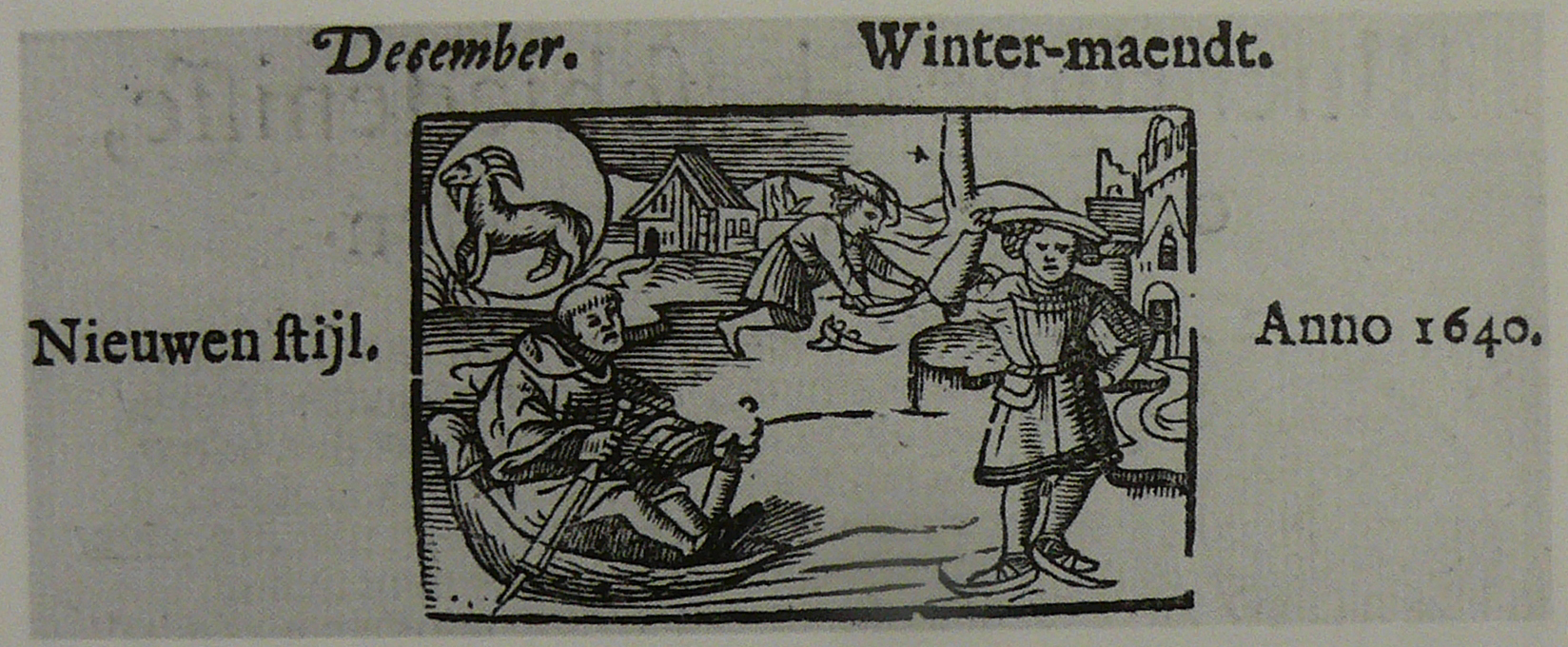
In his Populair drukwerk in de Gouden Eeuw (p. 173), Jeroen Salman refers to an almanac printed by Broer Jansz in Amsterdam in 1640. The months have been depicted in traditional, medieval agrarian fashion, as he writes. The woodcut belonging to the month December presents an unmistakable wintry scene (fig.1): the landscape is barren and the water is frozen. Three figures are to be seen on the ice. One of them is seated in an ice sledge, another is standing on skates. With his right hand at the rim of his hat, he would appear to salute the viewer. In the background in the middle a third figure is busy putting on his skates. The zodiac sign of Capricorn in the circle above left is an extra clue that we are dealing with the month of December. The style of this image, however, is not usual for the 17th century. How can this be explained? A study of several calendars yielded a strong similarity with the December image in a 1513 Shepherd’s calendar.
Shepherd’s Calendars
What are shepherd’s calendars? They are a distinct group within the category of almanacs which long enjoyed great popularity, especially because of their fine woodcuts. According to the Royal Library exhibition, the success of the Shepherd’s Calendar was partly due to the ‘wise proverbs it contains’:
The magical attraction of an idealized shepherd plays a significant role as well – someone whose days are spent philosophizing amidst his flock and whose nights are devoted to a detailed study of the stars. The shepherd is the symbol of a happy, satisfied and unpretentious man, someone with a rather carefree existence (who at the same time serves as a model for a healthy and, more important, less sinful life (ref.3). See KB-Collection, 1609: Shepherds
1513 Winter Woodcut
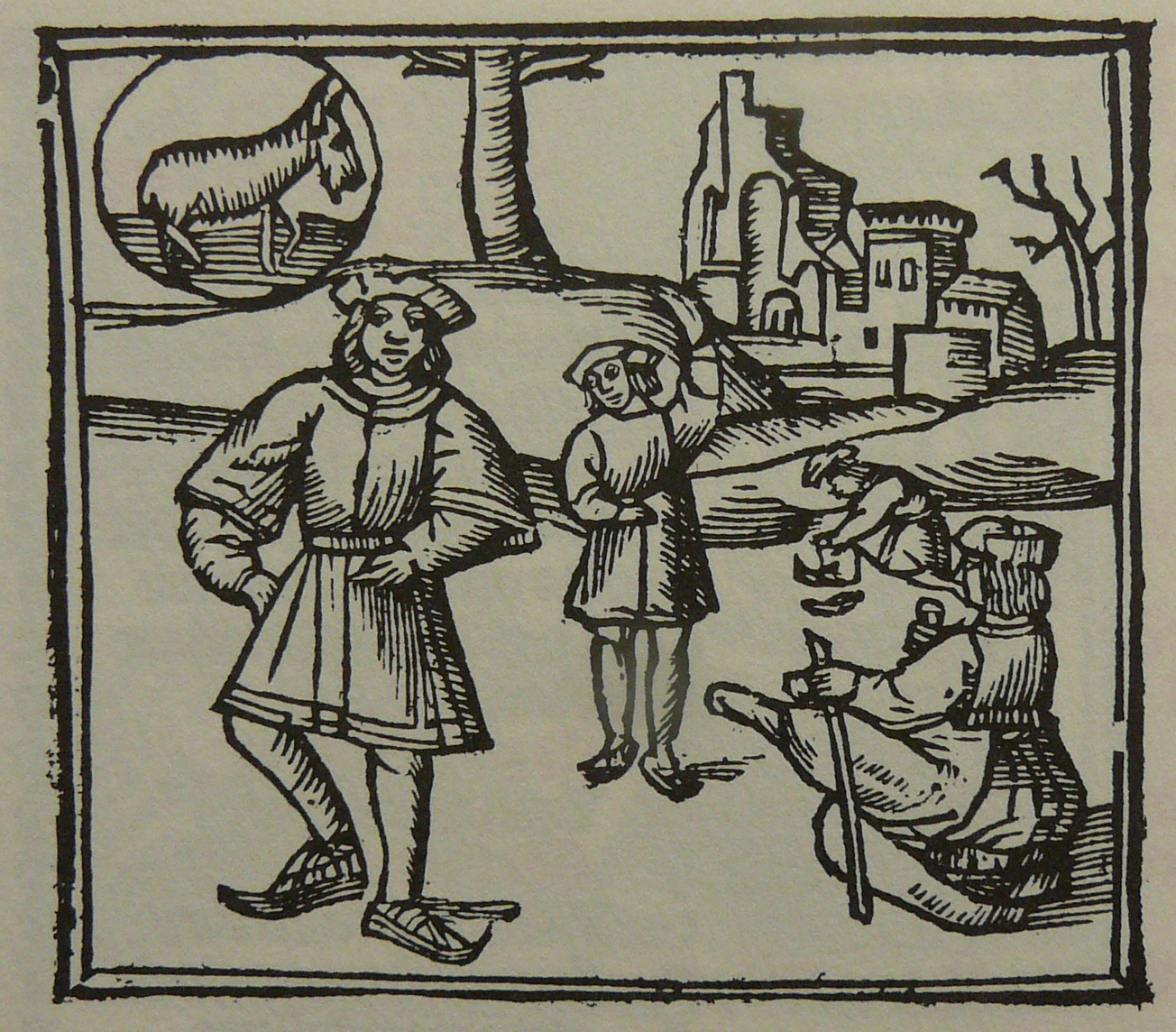
The first Shepherd’s Calendar was printed in France in 1491, soon followed by editions in England and Germany. The oldest Dutch Shepherd’s Calendar was printed by Thomas van der Noot in Brussels in 1511. It is Willem Vorsterman’s 1513 Antwerp edition of Der Scaepherders Kalengier that is of importance to our story. Only one copy of this edition has survived, which was reprinted in a modern edition in 1985. A copy of this modern edition is also present in the Royal Library (ref.4). The Kalengier was based on a French version, but the image accompanying the month of December was altered in the Dutch edition. Instead of a traditional domestic scene showing an open fire and a table filled with delectables, the Dutch edition has a woodcut with a skating scene (fig.2).
Similarities
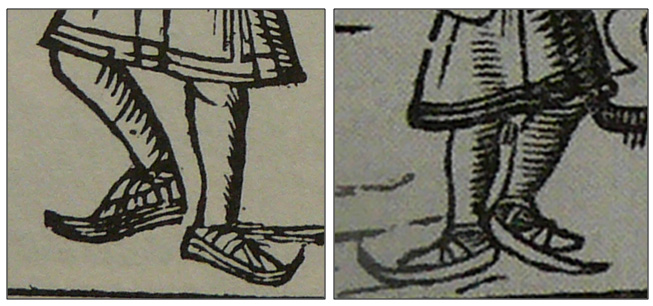
It is this 1513 image which shows clear similarities with the December image in the 1640 Shepherd’s Calendar. With the exception of the circle containing the Capricorn above left, the two pictures are in mirror image to each other. There are four figures on the ice in the 1513 image, one less in the 1640 woodcut. Although there are fewer persons in the later woodcut, the activities are essentially the same. The 17th-century woodcutter probably had difficulty with the shape of the sledge. But the similarity of form between the man standing in the foreground in the 1640 image and that of the 1513 one is remarkable. Apart from the raised arm, the posture in the two images is virtually the same, especially if we look at the position of the legs. Even the skates with their bindings have been depicted in the same way (fig.3). All these similarities make it plausible that the 17th-century woodcutter may have been inspired by the 1513 woodcut.
Blockhouses in the River Amstel
Salman included yet another skating scene in his Populair drukwerk in de Gouden Eeuw (pp.173-4). It is an ice scene accompanying the month of December from the Groote comptoir almanack published by Gillis Joosten Saeghman in Amsterdam in 1666 (fig.4). The image shows several types of fun on the ice. A horse-drawn sleigh crosses the ice, two men are playing a game of ‘kolf’ and on the right a couple is skating hand in hand. A few smaller figures skating with a stick over their shoulder can be seen in the background. Although the skating figures are obviously dressed according to contemporary fashion, the skates have been rendered fairly crudely and are more reminiscent of their medieval predecessors.
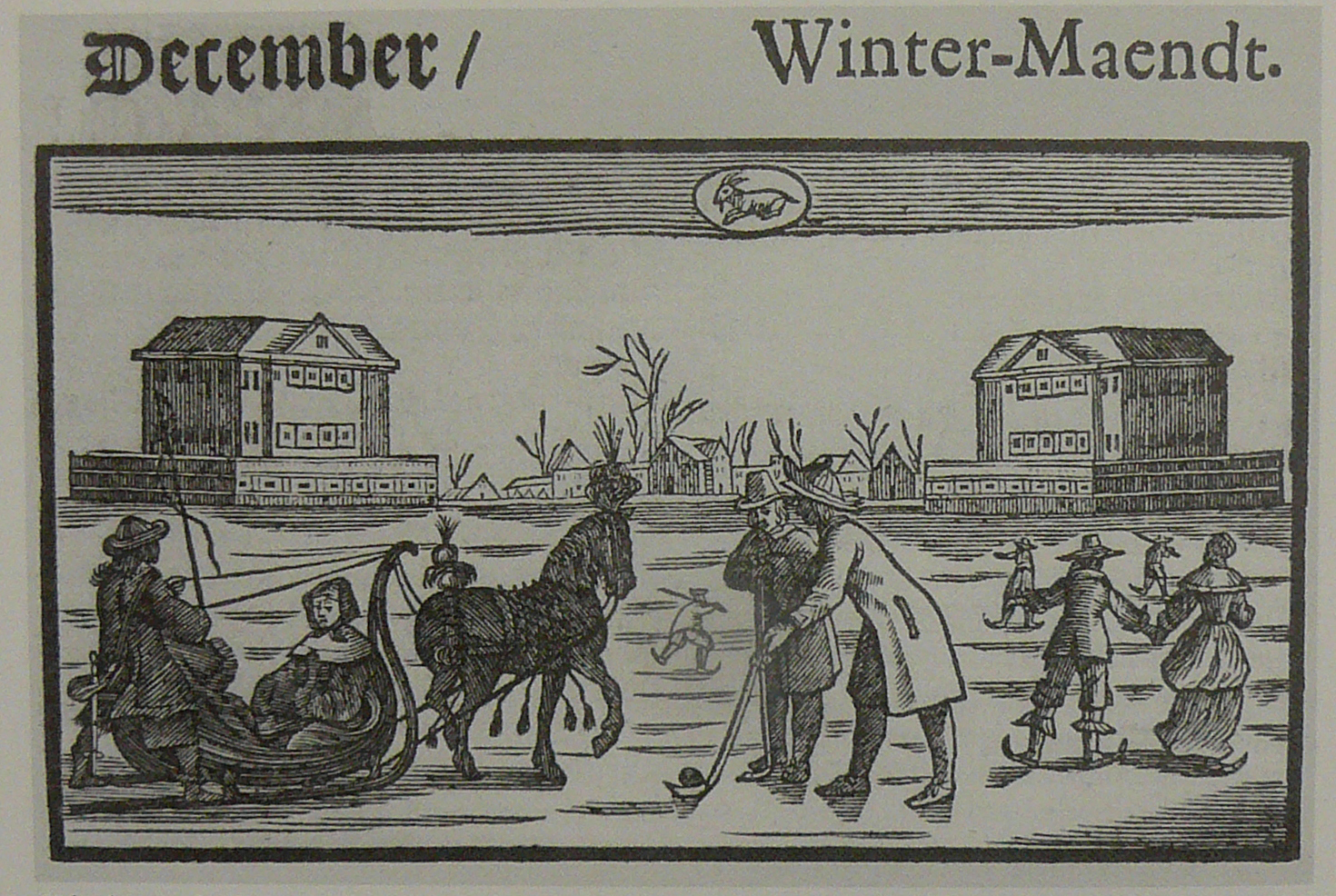

Borrowing
Left and right on the horizon are two blockhouses, which have been so beautifully rendered by Hendrick Jacobsz Dubbels (1621-1707) in one of his paintings (ref.5,6) (fig.5). We can tell the skating scene takes place on the river Amstel thanks to these blockhouses. In the woodcut in Saeghman’s calendar, the loophole shutters in the lower storey are closed. As canons were only positioned on the side of the fortification facing away from the city, we know the view in Saeghman’s calendar is from the south. Dubbels for his part painted the blockhouses as viewed from the city itself. This is clear from the arches with latticework at water level. The blockhouses, which were built as fortifications in 1651, were already demolished three years later. Because of the piling involved in constructing them, the river Amstel was silting up, which proved too great an obstacle for shipping. The blockhouses are still to be seen in the calendar image from 1666, even though they had been removed more than a decade before (fig 6).
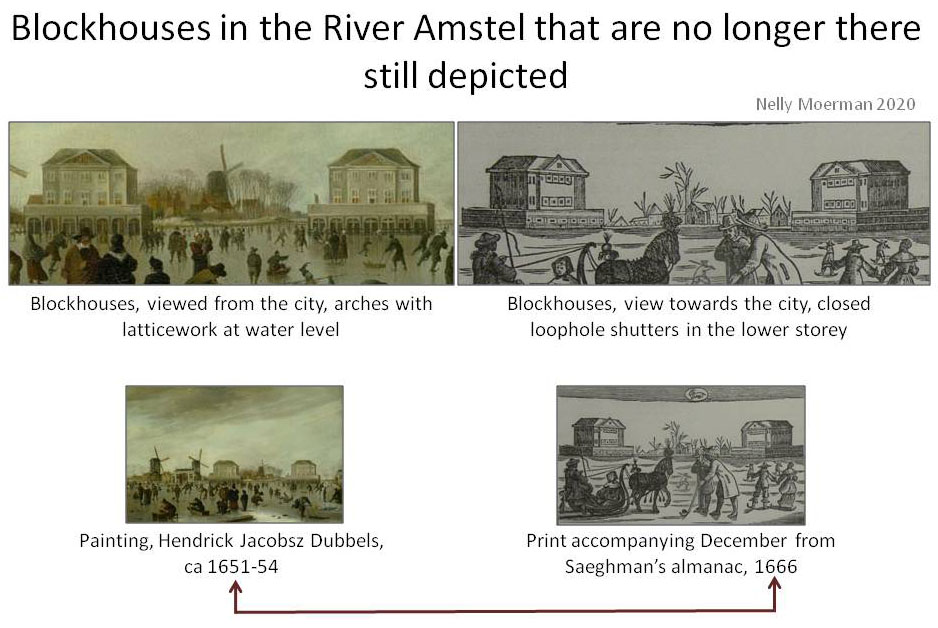
Pictorial art as an Indication of Time
The skating scenes here discussed make clear that a contemporary image may contain elements that were actually no longer there at the time the image was made. On the whole this is not a problem because we understand what the image as a whole wants to convey. The time is winter, it is cold and people are skating. What about the historical reliability of what is depicted, though? Skating collectors are generally keen to date skates to the correct year or period, and examples from the pictorial tradition are often used as a source of information to date ancient skates (ref.7). It is for this very reason that it is important to realise that ‘borrowings’ were not uncommon and furthermore that the image depicted may reflect another time than the period in which the work of art was made. By bearing such facts in mind, the joy of collecting will only increase.
References
1) Jeroen Salman, Populair drukwerk in de Gouden Eeuw: de almanak als lectuur en handelswaar. Zutphen, Walburg Pers 1999.
2) KB National Library of the Netherlands, A matter of time (not available anymore)
3) KB National Library of the Netherlands, 1609: Shepherds
4) Der scaepherders kalengier: een Vlaams volksboek, naar het unieke exemplaar van de Antwerpse druk door Willem Vorsterman van 1513, [edited and introduced by W.L. Braekman], Brugge 1985.
5) Nelly Moerman, De Blokhuizen in de Amstel bij winter, in: Niko Mulder & Jos Pronk, Acht eeuwen schaatsen in en om Amsterdam. Amsterdam, De Poolster 2014, pp. 26-29.
6) Nelly Moerman, De Blokhuizen in de Amstel, Amsterdam, Universiteit van Amsterdam, 2009.
7) Nelly Moerman, Vroege schaatsafbeeldingen, Amsterdam, Universiteit van Amsterdam 2011.
Credits
The calendar images are taken from Jeroen Salman’s Populair Drukwerk in de Gouden Eeuw (1999), courtesy of the author.
De Blokhuizen in de Amstel bij winter, a painting by Hendrick Jansz Dubbels (1621-1707), is part of the collection of the Amsterdam Museum (inv.no. SB 4521) as a loan from the Stichting Genootschap Amsterdam Museum.
© Nelly Moerman 2020
This article is protected by copyright. Reproduction of the text, in whole or in part, is permitted only on an individual basis and under the conditions of acknowledgement of source and correct citation. In case of a financial interest or the pursuit of such an interest, copying is not allowed. In case of doubt, please contact the author.